Are you a Quiet Speculation member?
If not, now is a perfect time to join up! Our powerful tools, breaking-news analysis, and exclusive Discord channel will make sure you stay up to date and ahead of the curve.
Unbannings always trigger a surge of interest, articles, and brewing. When the card's utility and thus its home is obvious, the cards is quickly adopted, as was the case for Bloodbraid Elf. For those whose power is tougher to unlock, interest and visibility wanes while the hard work is done. Such is the case for Stoneforge Mystic.
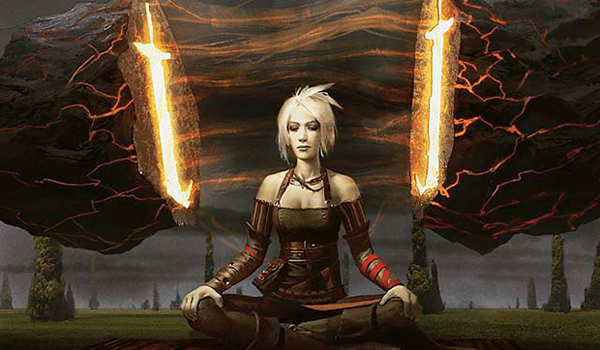
I've been working with Stoneforge Mystic since the unban, and getting the Kor to consistently perform has proved surprisingly frustrating. Today, I'll be explaining my results and discussing why it's so hard to actually wield Stoneforge in Modern.
A Note on Pioneer
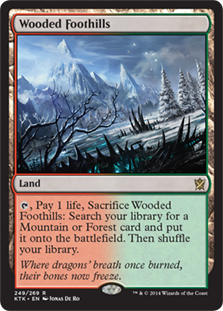 The additional announcement of the Pioneer format was interesting, but there's not much to say at this point. Wizards didn't say much in the announcement other than that it exists and the fetchlands are banned. All this tells me is that they're worried that it will go the way of Frontier, which is understandable. The fetchlands and Battle for Zendikar duels and lack of punishment for greedy mana meant that 4-5 color good stuff dominated everything. Lack of metagame shifts or diversity killed existing interest while lack of support prevented growth. Whether banning fetchlands saves Pioneer from the same fate is impossible to say right now. If it does, then this would functionally push Modern into Legacy's niche. If Pioneer fails then the status quo will remain. We just have to wait and see.
The additional announcement of the Pioneer format was interesting, but there's not much to say at this point. Wizards didn't say much in the announcement other than that it exists and the fetchlands are banned. All this tells me is that they're worried that it will go the way of Frontier, which is understandable. The fetchlands and Battle for Zendikar duels and lack of punishment for greedy mana meant that 4-5 color good stuff dominated everything. Lack of metagame shifts or diversity killed existing interest while lack of support prevented growth. Whether banning fetchlands saves Pioneer from the same fate is impossible to say right now. If it does, then this would functionally push Modern into Legacy's niche. If Pioneer fails then the status quo will remain. We just have to wait and see.
The Bladesmith's Forge
After weeks of testing, my overwhelming impression of Stoneforge Mystic is confusion. I don't understand what is going on with the Mystic package in relation to the rest of Modern. Results, both in pure testing and in tournament settings, have indicated opposing forces and effects at work. On the one hand, Stoneforge is a very strong value card as well as a game-winning threat. On the other, it is a very awkward, slot-intensive package that isn't very good if drawn out of order. Swords and Batterskull didn't see play before Stoneforge for a reason, and if you've drawn them, Stoneforge becomes a very bad threat. The whole is greater than the sum of the parts, but when the parts come individually, they're terrible. Playing with Stoneforge therefore has a very schizophrenic feel.
Game-Changing...
The strongest argument in Stoneforge's favor is that it is game-warping. Once Mystic is in play, the opponent always has to pause and reevaluate their entire gameplan. Unanswered, Batterskull is a five-turn clock that makes it significantly harder for many decks to kill the artifact's controller. Active Swords can be more threatening if the protection or triggers are particularly relevant, like Sword of Feast and Famine against a combo deck. Thus the game becomes about the Mystic. If you can kill 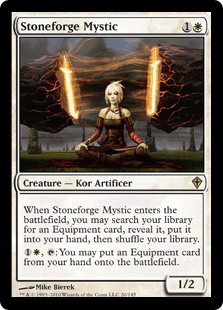 her, it is almost always correct to do so immediately. If not, then the only option is to find a way around the Batterskull. This is easier said than done, since a 4/4 vigilance creature is a significant body in almost every matchup.
her, it is almost always correct to do so immediately. If not, then the only option is to find a way around the Batterskull. This is easier said than done, since a 4/4 vigilance creature is a significant body in almost every matchup.
Worse, you have to destroy the artifact to remove the threat, and not many decks can do that in Game 1. Control will get grinded out, while aggro and combo will have to race. As my original testing suggested and subsequent testing has shown, this is very hard. Ground-based aggro like Humans can't really punch through 'Skull. Meanwhile, even evasive aggro struggles. While Spirits just flies over the Germ, it still has to deal four extra damage every turn to actually make progress. This lengthened clock in turn incentivizes aggro to overextend to try to win the race, leaving them vulnerable to sweepers. In addition to being a solid threat, Stoneforge has a disruptive effect by warping opposing gameplans and demanding answers that in a vacuum aren't useful in the overall matchup.
...But Not Meta-Shifting
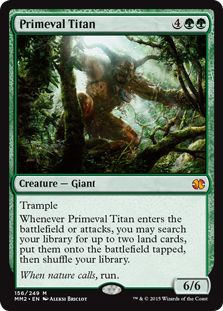 Despite its effects on individual games, Stoneforge has made little measurable impact on the metagame at large. We are still in a turbulent time, and the metagame has only begun to settle, but there is no widespread adoption of blue-based midrange going on. This is understandable, since just as with Jace, the Mind Sculptor beforehand, it is very hard to incorporate new cards into fair decks.
Despite its effects on individual games, Stoneforge has made little measurable impact on the metagame at large. We are still in a turbulent time, and the metagame has only begun to settle, but there is no widespread adoption of blue-based midrange going on. This is understandable, since just as with Jace, the Mind Sculptor beforehand, it is very hard to incorporate new cards into fair decks.
There's a lot more need to balance and tweak something fair than something busted. The former needs the right balance of supportand power cards, the latter mostly needs enablers. Even when the right balance is found, the actual effect of the fair card may be worthwhile, but too subtle to independently detect. Another factor may be the overall metagame being hostile. Amulet and Tron did very well in Indy, which is very bad news for blue decks.
Bottom Line
Stoneforge's advantages seem to be balanced by its weaknesses. The game-warping power is balanced by clunkiness; the increased pressure on aggro by reduced answers for other decks. Therefore, on net, Stoneforge is currently an ambiguous addition to Modern. It's certainly playable, but additional work is needed to make it great. That work may best be left in the hands of others, as all the avenues I've explored have led to frustration.
Stoneblade Meandering
When the unbanning happened, some joked that the change provided a great opportunity for Legacy Stoneblade players to 5-4 Modern events. I've come to understand the reasoning 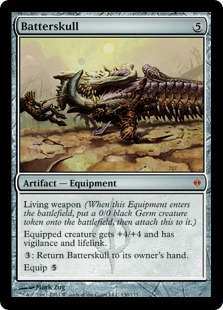 behind this joke. Stoneblade is not putting up impressive results, and every deck I've tested felt poor for different reasons.
behind this joke. Stoneblade is not putting up impressive results, and every deck I've tested felt poor for different reasons.
The devil is in the details. A control deck can just slap more powerful answers or card advantage on its problems, but Stoneblade has to balance the answers against its threats. The need to hit Stoneforge on-curve also makes the manabase trickier: there's a lot of tension over how many Celestial Colonnades can be run before the deck fails to curve out or has to kill itself with shocklands to make it work. More refinement may be all that Stoneblade needs for a major breakout, but it feels like there's also raw power missing, and I'm not sure if it's on the answer or threat side.
Jeskai
I stated where most of the metagame started, Jeskai Stoneblade. On paper it seemed like the perfect home. Lots of answers to clear the road for threats, solid protection, and the option to burn the opponent out is a very solid strategy, and making the threats even better seemed legit. 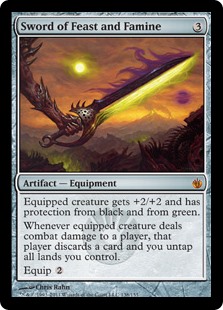 Stoneforge stood to be especially potent here since Sword of Feast and Famine is exceptional in a deck that needs to tap out for threats but is also packed with counterspells. However, despite hype and expectations leading up to SCG Dallas, nothing happened. In fact, the only big result was a Top 4 in Ghent.
Stoneforge stood to be especially potent here since Sword of Feast and Famine is exceptional in a deck that needs to tap out for threats but is also packed with counterspells. However, despite hype and expectations leading up to SCG Dallas, nothing happened. In fact, the only big result was a Top 4 in Ghent.
Based on my experience testing the deck, I think it comes down to the metagame. Jeskai thrives on picking apart small creature decks and out-tempoing slow decks, and that's not the metagame we seem to have. I initially tried to simply turn my Jeskai tempo deck from 2018 into Stoneblade, but quickly discovered that even with a Sword, Geist wasn't good enough. I had to cut too many answers to fit in all the creatures and the Stoneforge package, so Geist had to go. Then, despite constant tweaks to that answer package, I never found the right mix to both keep me alive and clear the road. There's too much Jund, Urza combo, and Amulet Titan pulling me in too many directions to make Jeskai a sane deck. If things settle towards the middle or move toward creatures then Jeskai is definitely where I want to be.
Jeskai Stoneblade, David Ernenwein (Test Deck)
Esper
The other control option was Esper Stoneblade. Considering his history of whining and being wrong about Modern control and general disdain for the format, I hate to agree with Shaheen Soorani. However, he's right that Esper Stoneblade is the right vercion for a combo- or even control-heavy metagame. Thoughtseize is the answer to everything, and just better at ensuring the road will be clear than any other option. The removal is also much more decisive, and Drown in the Loch is an extremely powerful Game 1 card. I also frequently board it out because this is the kind of deck that opponents absolutely will bring in graveyard hate against.
Esper Stoneblade, David Ernenwein (Test Deck)
The problem is that the deck is very dependant on Stoneforge. Lingering Souls is a very strong card against control and Jund, and the overall answer package can get there, but it's really hoping that it doesn't have to. There's just not a lot of closing power unless Stoneforge has survived, and that means the comparatively thin answer package can be overwhelmed. That's not as big an issue if combo is popular, and the deck can easily be tuned to pick control apart, but doing that and maintaining the staying power to beat aggro or Tron is very hard. I think this is a better pick than Jeskai right now, but I'm still unhappy with it.
Azorius
Azorius Stoneblade has more results than the other versions, but it's also the version that I like the least. The idea is to take the less painful manabase, add utility lands and Spell Snare, and prey on all the other midrange decks. This is not bad in theory, but I've consistently found it to be a triumph of hope over reality. There's nothing about UW Stoneblade that feels better than the alternatives, and it frequently feels like playing bad UW Control. Running the 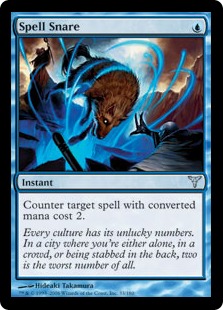 Stoneforge package means cutting planeswalkers and answers, and those have always been the main advantages of UW. Stoneblade must get by on situational counters and Path to Exile. In practice, I always feel behind against everything and struggled to catch up unless turn-three Batterskull goes unanswered. At least with control I knew when I was actually winning.
Stoneforge package means cutting planeswalkers and answers, and those have always been the main advantages of UW. Stoneblade must get by on situational counters and Path to Exile. In practice, I always feel behind against everything and struggled to catch up unless turn-three Batterskull goes unanswered. At least with control I knew when I was actually winning.
Some lists have taken to running Mystic Sanctuary to create a Cryptic Command soft-lock. While it can be powerful, it is not a cure-all. If you're looping Cryptic, you can't do anything else; you don't draw a new card for the turn, so your board is effectively locked. It gets worse if you need to loop Cryptic to not die to creatures, since now the opponent can simply find an answer or a planeswalker, resolve it, and power through. The only way to make the loop good is if you have an additional constant source of card advantage or a clock in play, and as mentioned, such can prove a tall order for Stoneblade decks. I'd run straight UW Control with Sanctuary rather than Stoneblade.
Aggro Rising?
I haven't seen Stoneforge in aggro decks very much. Then again, I haven't been seeing that many results for aggro in the first place. I'd blame the heady combination of Jund and Urza currently dominating. The former is generally good against aggro thanks to waves of removal, and the latter is hard-to-disrupt combo. Given that Humans can't run Stoneforge due to mana issues, it makes some sense that Stoneforge hasn't seen much play in creature decks.
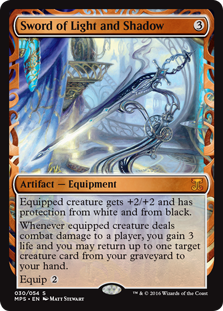 However, that doesn't mean that it won't work. I took UW Spiritblade to an MCQ last month and it performed well, although I missed Top 8 on tiebreakers. The Stoneforge package, specifically Sword of Light and Shadow, was critical to wins over Jund and Esper Control. As a grinding tool, I've never found anything better that works consistently in aggressive decks. The problem is that you need to be doing a lot of grinding for it to really matter, as the aforementioned awkwardness is palpable in an aggressive deck. Over longer games, the initially dead cards become more relevant and playable, and what had been awkward bricks change to game winners. However, my meta shifted away from control and towards combo and big mana, so I cut the package.
However, that doesn't mean that it won't work. I took UW Spiritblade to an MCQ last month and it performed well, although I missed Top 8 on tiebreakers. The Stoneforge package, specifically Sword of Light and Shadow, was critical to wins over Jund and Esper Control. As a grinding tool, I've never found anything better that works consistently in aggressive decks. The problem is that you need to be doing a lot of grinding for it to really matter, as the aforementioned awkwardness is palpable in an aggressive deck. Over longer games, the initially dead cards become more relevant and playable, and what had been awkward bricks change to game winners. However, my meta shifted away from control and towards combo and big mana, so I cut the package.
That said, I'm confident that in a different meta or build, Stoneforge will excel. Having a threat that demands answers and is at least a cantrip is very rare for the aggro, and the threat of turning into an unsolvable threat can be potent. The question of how to do that remains, and I don't have answers. Spirits and synergy-based decks aren't the answer, mainly due to the lack of cohesion: Spiritblade really felt the pinch when I wasn't triggering Mausoleum Wanderer or couldn't flash in Mystic with Rattlechains. A more goodstuff-oriented shell is necessary for Stoneforge to excel.
Death and Taxes
Legacy's best Stoneforge Mystic deck is still struggling in Modern. I've tried a number of different builds with Stoneforge, and they haven't impressed me, mostly due to the weakness of Death and Taxes in general. The deck has always been underpowered compared to other decks. In Legacy, Thalia, Guardian of Thraben is a house, and most creatures are on the small-and-cheap side. But in Modern, size matters far more. Every DnT deck I've ever tried has felt anemic compared to other decks, particularly other creature decks. Going the Eldrazi route helps somewhat , but adds mana issues. Additionally, when the disruption doesn't line up, the deck flounders.
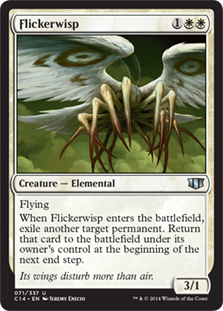 Mystic helps with the power problem, though not quite enough. The bonus from Swords is very welcome, particularly when the protection is relevant. However, it is rather slow and vulnerable to removal in response to equipping creatures. It's also not that hard for certain decks to answer the equipment itself, setting pilots back to square one. Batterskull is a decent threat, but often outclassed on the ground. As a recurring threat or when equipped to a flier it can swing games, but it can also be so clunky that it never gets going.
Mystic helps with the power problem, though not quite enough. The bonus from Swords is very welcome, particularly when the protection is relevant. However, it is rather slow and vulnerable to removal in response to equipping creatures. It's also not that hard for certain decks to answer the equipment itself, setting pilots back to square one. Batterskull is a decent threat, but often outclassed on the ground. As a recurring threat or when equipped to a flier it can swing games, but it can also be so clunky that it never gets going.
What I've found is that the threat of the equipment is far greater than its reality, and opponents alter their play patterns to my advantage. Jund will hold onto Kolaghan's Command or Assassin's Trophy rather than just using it to stabilize. That threat can be leveraged into considerable tempo and incremental value, which can then turn into game wins. For that reason, I feel that moving away from disruption and towards card advantage is the right call in a vacuum. However, given that Urza combos seem to be rising that seems like a very poor idea. My guts says that DnT is very close now to being a real deck, the problem is finding exactly the right mix of relevant disruption and power to make it work.
Outside Shots
 I've also heard chatter about other Stoneforge aggro decks, but that hasn't turned into anything concrete. Right after the unbanning, players were trying to make Stoneforge Zoo work. Zoo is a goodstuff aggressive deck focused on bigger creatures. In theory, this solves DnT's power problem. However, I haven't actually seen results. Zoo's problem is that it's too medium in Modern's metagame, and Stoneforge doesn't sufficiently fill in the gaps.
I've also heard chatter about other Stoneforge aggro decks, but that hasn't turned into anything concrete. Right after the unbanning, players were trying to make Stoneforge Zoo work. Zoo is a goodstuff aggressive deck focused on bigger creatures. In theory, this solves DnT's power problem. However, I haven't actually seen results. Zoo's problem is that it's too medium in Modern's metagame, and Stoneforge doesn't sufficiently fill in the gaps.
Meanwhile, there are rumblings that Mardu Stoneblade is a thing. The theory is that if you pack all the removal alongside Seasoned Pyromancer, then Batterskull- or Sword-wielding spirit tokens can cruise to victory. I'm skeptical that it will given Mardu's history, but anything is possible.
Too Stoned
I predicted that it would take time for Stoneforge to actually find a home in Modern, but I may have underestimated how much. I've spent a while looking already, and feel like I'm going in circles. Here's hoping someone cracks the code soon





